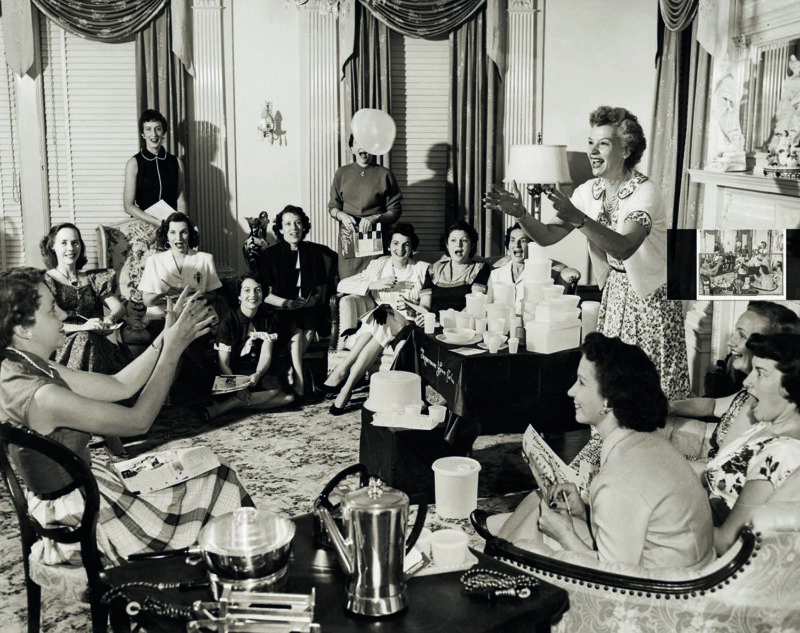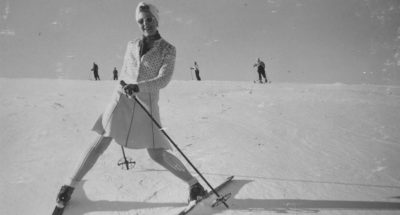
History Lessons
Tupperware: A Love Story
How one woman transformed a modest food container into an iconic must-have for home chefs.
Disclaimer: While Tupperware may not seem to be, on the face of it, a subject worth our readers’ veneration, DP begs to differ. Daisy Prince would like to dedicate this story to her mother, who has hoarded every piece of Tupperware (in all its multi-sized, multi-colored, mismatched glory) she has ever received. No summer picnic would be complete without it.
In the late 1940s, Brownie Wise—a divorced single mother—spotted a new product called “Poly-T” in a department store. It was a line of sleek, modern, plastic food-storage containers that came in a rainbow of colors, including orange, raspberry, “sapphire,” and “frosted crystal.” The containers had air- and water-tight “burpable” lids to keep the contents fresh. While innovative, the product line wasn’t selling well. Home cooks, used to storing food in glass or ceramic containers, were wary of plastic and perplexed by the strange lid. Wise’s chance encounter with Poly-T would eventually have a tremendous impact on food storage as well as product marketing and American business history.
Humble Beginnings: A Born Saleswoman
Brownie Wise was born Brownie Mae Humphrey in 1913 in Buford, Georgia. Her parents divorced when she was very young, and her mother took a job as an organizer for a hatmakers’ union. The job required frequent travel, resulting in Brownie being left in the care of her Aunt Pearl, a dressmaker near Atlanta. There Brownie was raised with a large group of cousins. She left school after the eighth grade and joined her mother in giving speeches at union meetings.
Brownie aspired to be a writer and illustrator, and in 1936, she won an art contest for which the prize was the opportunity to paint a mural at the Texas Centennial in Dallas. There, she met Robert W. Wise, who was in charge of the Ford Motor Company’s exhibit. In December of that same year, they married.
They moved to Detroit, where Robert Wise worked as a machinist. Two years later, in 1938, their only child, Jerry, was born. With a young child at home, Wise became a regular contributor to the “Experience” column in the Detroit News, a forum in which readers wrote about their lives. Wise chose the nom de pen “Hibiscus” and waxed poetic about her home, “Lovehaven,” and her wonderful husband, “Yankee.”
The truth was that Robert Wise turned out to be a violent alcoholic. They divorced in 1942, and Brownie Wise had a child to support. Although she worked in a clothing shop and as an executive secretary for Bendix, she needed additional income. She began selling Stanley Home Products, a Massachusetts-based company that sold cleaning supplies and kitchen necessities. Stanley was an early adopter of direct selling, and Wise demonstrated that she had a knack for it, quickly becoming one of the company’s top salespeople.
In 1949, when Jerry became ill, on his doctor’s advice, Wise moved her son—along with her mother—to Miami. She continued selling Stanley Home Products as well as West Bend and other home-related items—but added Poly-T to the offerings available through her new business, Patio Parties.
It Takes Two: The Inventor and the Innovator
At about the same time, Earl Tupper was sitting in his office in Leominster, Massachusetts, trying to figure out how to increase sales of a new product he had invented. During World War II, DuPont mass-produced polyethylene for war purposes. After the war, the company—hoping to find new uses for it—began distributing it to plastics companies. Tupper reached out to DuPont and asked if they would send him some polyethylene before it had stiffening agents added to it. With it, he created a new kind of pliable plastic he called “Poly-T: Material of the Future.” He molded it into lightweight food storage containers with a revolutionary double-sealed lid he debuted in 1946.
Tupper began to notice that there was one location in the country where the Wonder Bowl was selling head-spinningly fast: South Florida. Wise had adopted the home selling model of Stanley Home Products, which featured parties at which products were demonstrated, but there was also food, drink, socializing, and some lively games—such as tossing a sealed bowl filled with grape juice around the living room to demonstrate the strength of the seal—as well. The hostess would receive free product for hosting. Wise encouraged satisfied customers to become sellers themselves. And they did. One woman sold more than 56 bowls in a week in 1949.
Tupper—who had unsuccessfully tried to create a home party program for his product line—reached out to Wise, and in 1951 he hired her as his vice president of marketing for what was by then called Tupperware. That year, Wise had about 200 women selling the product. The company used marketing tactics such as the “carrot experiment.” Sellers would go door-to-door asking homemakers to place a few carrots in a Tupperware container and some in the container they would normally use. After several days, they’d return to compare freshness.
Wise incentivized her sales force with an annual event she called Tupperware’s Jubilee, a four-day sales meeting packed with motivational speeches, entertainment, new product introductions, and gifts such as appliances, vacations—even a speedboat. For many women, whose primary job was housekeeping and childcare, being rewarded for their intelligence, sales skills, and ambition was life-changing. “You build the people and they’ll build the business,” she liked to say.
By 1954, the Tupperware sales team had grown to more than 9,000. Sales hit $25 million that year (more than $240 million in 2021 dollars). Wise became the first woman featured on the cover of Business Week.
The Split: A Struggle for Power
Despite her success, by the late 1950s, a rift had widened between Wise and Tupper, and they argued increasingly over company strategy and management. He was looking to sell the company and didn’t want to do it with Wise, whom he considered too outspoken, at the helm. In the ensuing power struggle, Wise was pushed out by the board in 1958. She filed a $1.6 million lawsuit against the company for conspiracy and breach of contract, but wound up settling out of court for $30,000—about one year’s salary.
Wise went on to found three direct-sales cosmetics companies, but none of them really took off. She tried working in Florida real estate and as an artist of textiles and raku pottery, but never matched the level of success she had at Tupperware. She died in December 1992.
Still, to this day, if you look in your cupboards and cabinets, you’re likely to find at least one piece of Tupperware—maybe even a Wonder Bowl.

Hero image: To demonstrate Tupperware’s patented seal, Wise would toss bowls filled with liquid around the room. Photo by J. McCollum courtesy of Smithsonian National Museum of American History



